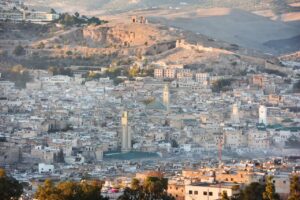Nestled in the heart of Morocco, Fez is a city that exudes historical charm and cultural vibrancy. Among its myriad of architectural wonders, Bab Boujloud, commonly known as the Blue Gate, stands as an iconic symbol of the city. This majestic gate serves as a grand entrance to the ancient medina of Fez, inviting visitors to step into a world where history, tradition, and modernity converge.
The Historical Significance of Bab Boujloud
Bab Boujloud was constructed in 1913 during the French protectorate, marking it as a relatively recent addition to the rich tapestry of Fez’s architectural heritage. Despite its modern inception, the gate was designed to blend seamlessly with the surrounding medieval structures. Its purpose was not only functional, providing access to the bustling medina, but also symbolic, representing a bridge between the old and new.
Architectural Marvel
What immediately captures the eye is the gate’s stunning facade. The outer face of Bab Boujloud is adorned with intricate blue mosaic tiles, which are a nod to Fez’s rich tradition of ceramic artistry. These blue tiles give the gate its popular moniker, the Blue Gate. In contrast, the inner face of the gate features green tiles, symbolizing peace and the city’s Islamic heritage. This duality in color creates a visual transition as one moves from the modern city into the historic medina.
The horseshoe arch, a hallmark of Moorish architecture, frames the entrance. Above the arch, delicate arabesques and geometric patterns intertwine, showcasing the exceptional craftsmanship of Moroccan artisans. The gate’s design is a testament to the enduring influence of Islamic art and architecture in North Africa.
Gateway to the Medina
Passing through Bab Boujloud, visitors are transported into the labyrinthine streets of the Fez medina, also known as Fes el-Bali. This UNESCO World Heritage site is one of the largest car-free urban areas in the world, preserving the essence of medieval city planning. The medina is a sensory overload, with its bustling souks, aromatic spice stalls, vibrant textile markets, and the rhythmic sounds of artisans at work.
Landmarks such as the Bou Inania Madrasa, an exquisite example of Marinid architecture, and the Al-Attarine Madrasa, known for its stunning zellij tilework, are within walking distance from the gate. Each step deeper into the medina reveals layers of history and culture, with Bab Boujloud serving as the perfect starting point for this journey.
Cultural Hub
Beyond its architectural beauty and historical importance, Bab Boujloud is also a cultural hub. The square just outside the gate often hosts local musicians, performers, and various cultural events. This lively atmosphere makes it a popular gathering spot for both locals and tourists.
Restaurants and cafes line the streets around Bab Boujloud, offering a taste of traditional Moroccan cuisine. Visitors can enjoy a cup of mint tea or a plate of tagine while soaking in the view of the gate and the vibrant life that surrounds it.
Conclusion
Bab Boujloud is more than just an entrance to the Fez medina; it is a symbol of the city’s enduring legacy and its dynamic present. Whether you are an architecture enthusiast, a history buff, or a curious traveler, the Blue Gate of Fez is a must-visit landmark that promises to enchant and inspire. As you pass through its arch, you are not just entering a city; you are stepping into the heart of Moroccan culture and history.




